How to make your own Sourdough Starter, using simple ingredients with no special equipment, in just six days, that can be used in our sourdough bread. Video.
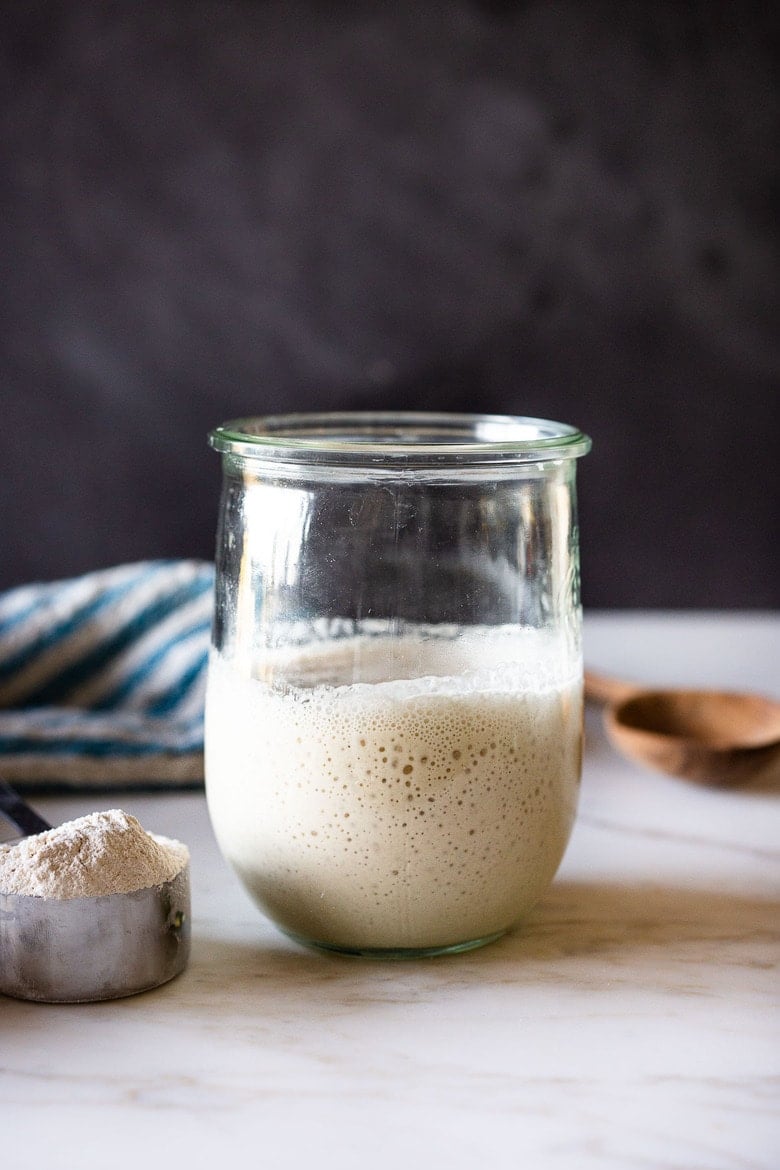
When you understand one thing through and through, you understand everything.~ Shunryu Suzuki
With over 500 five-star reviews and hundreds of success stories, my chef’s perfected sourdough starter guide has everything you need to make your own homemade starter. In just six days, you’ll be baking the most beautiful sourdough loaves!
But first, What is a starter?
Sourdough starter is a “wild yeast” made from flour, water, and the natural wild yeast in the air. With a little care and patience, it ferments, and when strong and active, just a little bit of starter replaces commercial yeast and makes your bread rise, while transforming the gluten in the bread into something more easily digestible. Store-bought yeast is not needed!
How to Make Sourdough Starter | 20-Min Video
***Don’t see the video? Allow 15-20 seconds to load it right here!*** (Still don’t see it? Check that your ad blocker is turned off; use Chrome for the best experience.)
Fast forward to Specific Day by video time (using scroll bar underneath video)
- Day 1 Morning: :23
- Day 2 Morning: 4:10
- Day 3 Morning: 7:00
- Day 3 Evening: 9:12
- Day 4 Morning: 11:50
- Day 4 Evening: 13:37
- Day 5 Morning: 14:45
- Day 6 Evening: 16:50
- Day 6 Morning: 18:12
- Day 6 Evening: 20:10
Sourdough Starter Recipe Ingredients
- Jar – A wide-mouth quart jar or a Weck’s 1-liter tulip jar.
- Flour – 5 lb bag of organic bread flour (plus 1 cup organic whole grain flour )
- Water – filtered water, tap water, or mineral water (specifically, San Pellegrino, for the correct mineral ratio). Distilled water does not have enough minerals.
- Scale – using a kitchen scale is optional but handy.
- Thermometer – Knowing the temp of the starter using a thermometer is optional but handy!
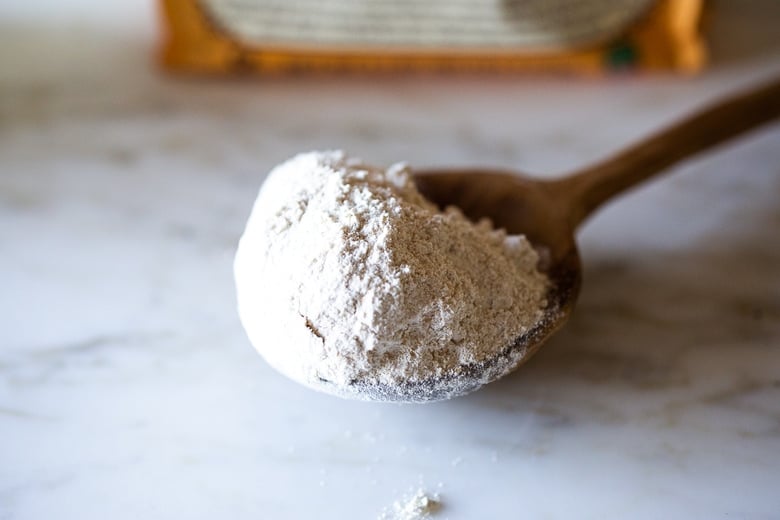
Understanding starter
- Think of sourdough starter as yeast. Only in this case, instead of buying a packet of yeast from the store, you are making your own living “wild yeast” by fermenting flour and water. Once it’s bubbly and happy, it is very much ike a very low-maintenance pet.
- You must feed it (stir in a mixture of flour and water) once a week to keep it active and strong. You know it’s happy when it bubbles. 😉 And YES, you can even name it.
- Some people believe that bread made with sourdough starter is actually better for you than bread made with yeast. Here and Here are a few articles to get you started on your own research. While I’m not sure if this is scientifically proven, I do know that bread made with sourdough starter, tastes infinitely better, feels easier to digest, and has more complexity and better texture, than bread made with commercial yeast. So if you are a bread lover- this is absolutely the way to go, as far as the quality of your finished bread.
How to Make Sourdough Starter
*See the recipe card for detailed instructions.
This recipe for Sourdough Starter takes 6 days (or up to 12 days if it is very cold where you live). For a primer, watch the 20-minute Sourdough Video above!
Day 1: Staring in the morning or at night, using a wide-mouth quart jar, tulip jar, or Crock or Glass Measuring Cup , mix 1 cup whole grain flour (120 grams) with 1/2 cup filtered water (120 grams) using a fork (or chopstick) making sure you’ve incorporated all the dry flour.
Place the lid lightly on top (using the Weck jar lid is really handy here) or a wet towel to keep moisture in, or plastic wrap- and let sit at room temperature (70-ish degrees) on the kitchen counter for 24-48 hours. If you are unsure how warm it is, use a kitchen thermometer and check it a few hours later. See notes for TEMPERATURE.
TIP #1: For your first measurement, weigh the flour using a kitchen scale so you can get an idea of how the mixture should feel. Do not weigh the measuring cup! It should be like a thick paste, like peanut butter. If you need to add a little more water to incorporate the flour, that is OK too!
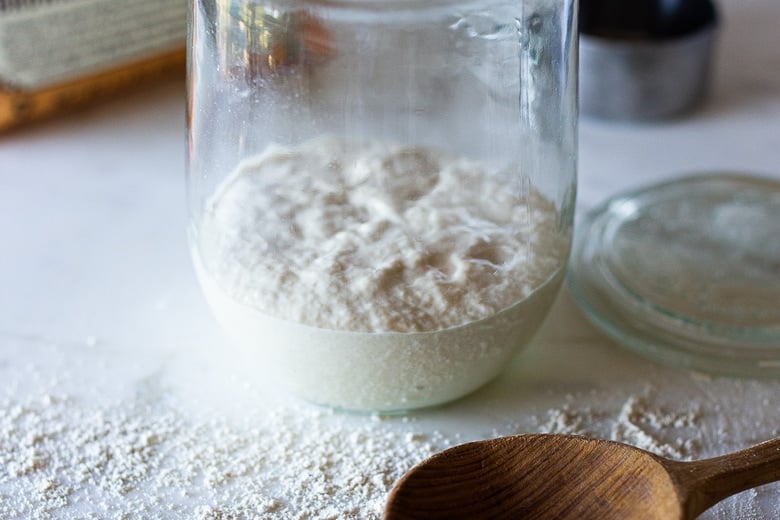
Day 2: After the first 24 hours, there may or may not be a bit of bubbling. Let the mixture rest until you see activity (bubbles or rising) sometimes this takes 36 hours or even 48 hours if very cold. When you see active bubbling, discard all but 1/2 cup of the starter (4 ounces).
To the remaining ½ cup of starter, stir in 1/2 cup water (120 grams), and mix well with a fork. Add 1 cup of organic bread flour (120 grams)spooned and leveled. Stir until combined. Again, it should feel like a thick paste. If overly dry, feel free to add a bit more water. Cover again and allow the mixture to sit at room temperature for another 24 hours.
Day 3: After 24 hours, hopefully, you will see some bubbling or rising and if not, let it go a bit longer until you see activity. Be patient.
Depending on how warm your house is and how active your starter, you may need to begin feeding more often or move to two feedings a day, in the morning and at night. If it is cold, one feeding a day may be enough.
TIP #2: Only feed the starter after it has peaked or looks hungry. See the “3 Signs of Hunger” below. Feeding it when it is “not hungry” will basically dilute all the growing yeast and make it lethargic. Better to underfeed than overfeed.
The 3 Signs of hunger
The photo below was taken after the starter was fed, and after it peaked (reached its highest), and now is sliding down. It is now “hungry” again. See the downward slide marks on the jar? Pay attention – your starter is telling you it is hungry.
- Look for “slide marks” (be sure to use a clean jar so you can see these clearly).
- Liquid at the top of the starter.
- Thin and runny. The starter is liquidy enough to pour out of the jar (when at room temp).

This might be 12 hours, it might be 14, it might be 18, or 24, depending on the temp in your house. In very warm climates, it may only be 6-8 hours. In winter, this may take 36 hours. It is better to underfeed rather than overfeed here.
For each feeding, discard all but 1/2 cup of the starter (keeping roughly ½-cup of starter in the jar). Add 1/2 cup water and 1 cup Bread Flour (spooned and leveled). Mix well, cover, and let this rest at room temperature for 12-24 hours or until the starter looks “hungry” again before repeating.
Day 4: Feed 1-2 times, discarding all but 1/2 cup of starter each time. Feed 1 cup bread flour, 1/2 cup water.
TIP #3: It is typical on day 4 for the starter to slow down and stall a bit. This is OK. Just keep going, be patient and look for the hunger signs, and only feed when clearly hungry. Hopefully, you’ll begin to see some rising and falling. It’s helpful to put the starter in a clean jar each day and mark the beginning level (with a sharpie, string or rubber band) so you can easily see this.
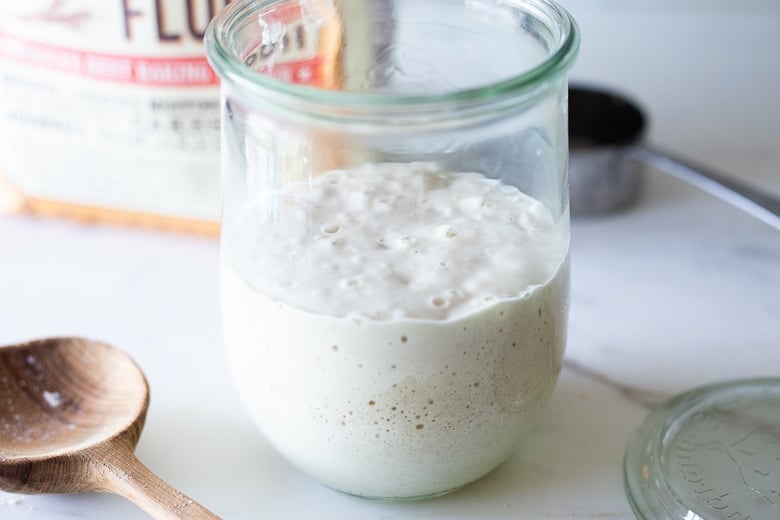
Above, you’ll see it peaking, and below, you’ll see it deflating and getting “hungry.” There may not be too much difference in the beginning, so look closely.
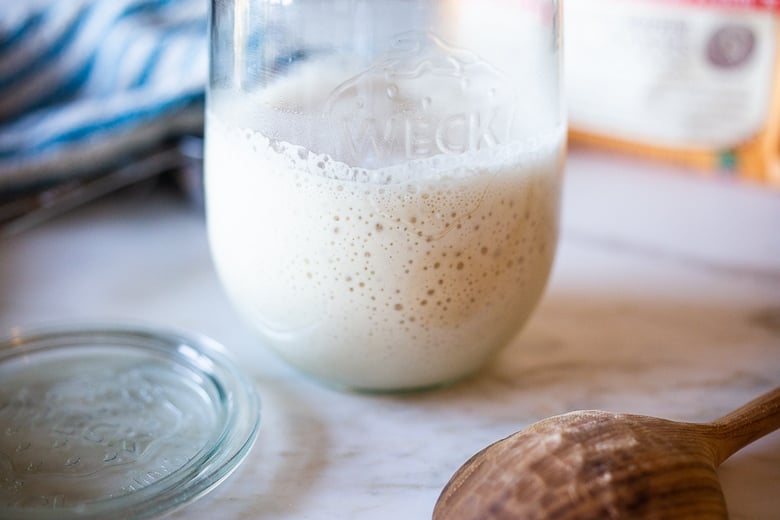
Understand that your starter has a schedule of its own; it is a living thing, so watch it and pay attention.
If your starter is not rising and falling, look at its consistency. As it metabolizes the flour and gets hungry, it will get runny and liquidy, like to the point where you can pour it right out of the jar. If it is still thick like paste, it’s not done metabolizing (eating)the flour.
Day 5: Feed again, 1-2 times, discarding all but a 1/2 cup the starter each time. Adding 1 cup bread flour and 1/2 cup lukewarm water. The starter should look visibly active, bubbling, rising, hopefully, close to doubling in size.
Repeat day 5 until the starter is rising and falling predictably and is close to doubling in size within 6-8 hours.
TIP #4: If your starter is not rising but there is evidence of hunger (liquidy or liquid at the top) try 3 things: substitute 1/4 cup whole grain flour (add to ¾ cup white bread flour) on your next feeding. Try using mineral water like San Pellegrino instead of water. Stir the starter a few times after feeding to allow more wild yeast from the kithcen to get inside.
DAY 6 Morning: Baking day! Give it one last feeding in the morning: this time discard all but a 1/3 cup. (The reason we are changing this to 1/3 cup is to feed it a little bit more.) Add 1 cup flour (120 grams) and 1/2 cup water, stir, and place it in a clean jar so you can see the action clearly. You can use a sharpie or place a rubber band around the jar to mark the beginning level. The starter should hopefully double in volume within 6-8 hours of feeding.
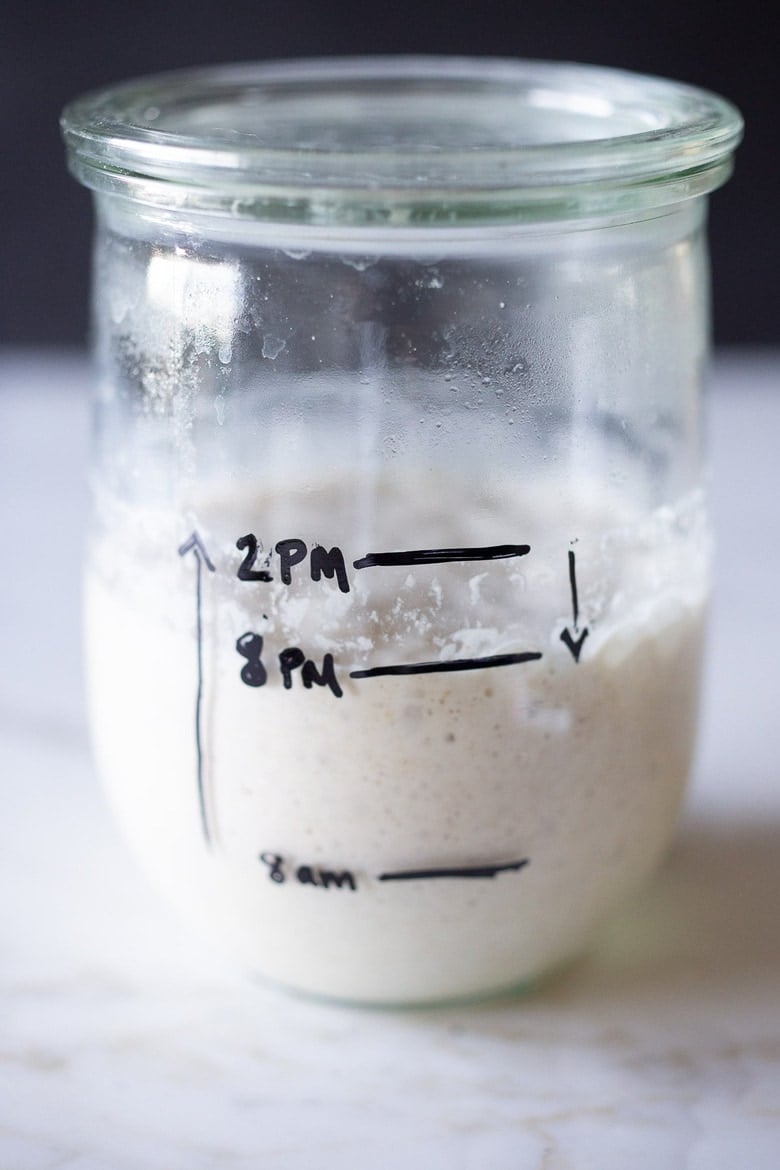
In the photo above, on the 6th day, the starter was fed at 8 am, it peaked around 2 pm, then it started deflating, and by 8 pm, it was “hungry” again. See those downward “slide” marks on the jar?
DO THE FLOAT TEST: When the starter is at its peak, or just after, place a teaspoon of starter (just from the top, don’t stir it down) in a glass full of water; it should hopefully float. If it floats, success!!! Congrats. You can now make our sourdough bread…tonight!
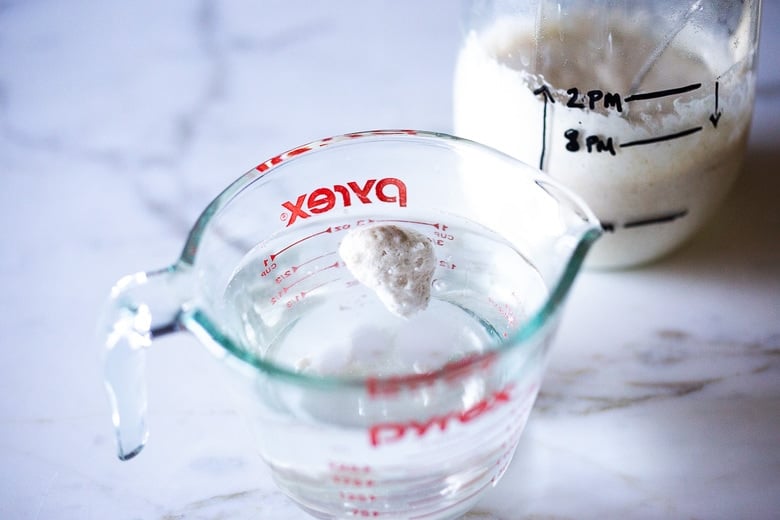
TIP #5: When baking bread always use hungry starter that has already peaked!
STARTER DOES NOT FLOAT? If it doubles in size but does not float, you can still try baking a loaf if it doubles within 6-8 hours of feeding it.
At this point, if your starter does not double in size within 6-8 hours of feeding, don’t give up! Often, it just takes longer, especially during the winter months. Continue feeding one to two times a day until you see a consistent, predictable rise and fall.
Read the troubleshooting section. If you need to take a break, put it in the fridge and try it again up to a week later. Don’t toss it!
Day 6 Evening: Let’s Bake! Use 1/3 cup starter to make this sourdough bread recipe and place the remaining starter (or if not making bread, place all of it) in the refrigerator, and feed it at least once a week, reserving ½ cup starter, before feeding it the usual 1 cup bread flour, 1/2 cup water.
TROUBLESHOOTING Starter
- SMELL: Starter should smell sweet, tangy, earthy, like a wet horse – not “bad”. If it really smells foul or unpleasant, you may have used an unclean jar, unclean utensil, or somehow introduced other bad bacteria. I would start over.
- NO ACTION: On day 4-5 it is typically for it to slow down. If your starter is not rising at all but there is evidence of hunger (liquid at the top, or bubbles) try 3 things. First substitute 1/4 cup whole grain flour (add to ¾ cup white bread flour) on your next feeding. If no rise, then try using mineral water, specifically San Pellegrino instead of water. San Pelligrino specifically has the right mineral ratio, I have great luck with it. Others not so much! Also try stirring the starter a couple of hours after feeding, a couple of times throughout the day to allow wild yeast from the room to get in there. Lastly, you could try pineapple juice instead of water.
- FLOUR: Try to use fresh milled whole grain flour to start, then organic BREAD FLOUR. The more wild yeast in the flour, the better your starter will do- so smaller brands like Bob’s Red Mill seem to do better than bigger conventional brands that have been overly processed. It is totally OK to mix flours and to switch them up- this adds different kinds of wild yeast- a good thing!
- DO NOT overfeed. For example, maybe feeding 2 x day at 12-hour intervals is too often. You want to feed after the starter has peaked, then deflated (see photo above- you’ll see some slide marks on the jar) and this tells you that it is hungry. If you feed the starter before it has had a chance to metabolize (or eat) all the flour (before peaking) and then you discard part of it, and feed it again, you are actually diluting all that amazing bacteria, weakening your starter. So it’s all about watching your starter in your home. If you are not seeing rising and falling, but notice the starter just gets liquidy, this too is a sign of “hunger”. Or if it gets runny enough to pour out of the jar, another sign it is hungry. There are lots of variables here. Just be patient, pay attention and watch. This is a living thing- it doesn’t care about time schedules and recipes or what it “should” do. It will “eat” when it is “hungry” and sometimes it likes to eat slowly. 😉
- TIME: It may take longer than 6 days in colder environments. Use a kitchen thermometer and take its temp. Is it over 65F? Find a place where it can be warm. In the oven with the light on, or in an upper cupboard ( heat rises). Sometimes it takes 12-14 days! Be patient, keep going. If it is doing absolutely nothing, leave it out on the counter for 24-48 hours and see what happens. If you run out of flour or need a break, don’t just toss it, put it in the fridge and see if you can get it going a few days later.
- ACIDITY: If you still can’t get that starter going, some people recommend subbing pineapple juice for the water for one feeding- raising the acidity level. My good friend just tried this and it got hers going.
- LIQUID: If you see any liquid at the top of your starter, it means your starter is hungry. So, yes it’s still alive which is a good thing! You can stir the liquid in, or pour the liquid out, either way, but feed it. This is a sign that you may need to feed it more often.
- MOLD: if you see any discoloring or mold on the surface, starter was probably contaminated. If it is only on the surface, it is probably ok to save. Scrape it off, save 1/2 cup of the underneath starter, and keep going, using a clean jar. Feed, smell, use your best judgment.
- FLOAT TEST: Try testing when your starter is peaking. Take a spoonful from the top without stirring it down. If your starter is rising and falling consistently, but not passing the float test and it has been over 8-10 days- just try baking a loaf. People are having luck with good loaves without passing the float test. It may be the flour…
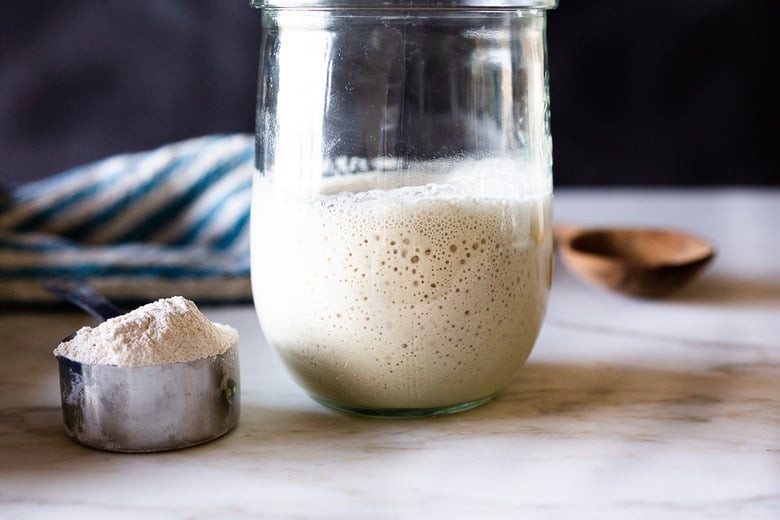
How to Maintain Your Starter
- REFRIGERATE & FEED AT LEAST ONCE A WEEK: Pick a scheduled day and try to stick with it, always reserving 1/2 cup and feeding it 1 cup flour and 1/2 cup water. Discard the remaining, give it away, or keep the discard in a separate container for sourdough pancakes, sourdough buns, banana bread, biscuits, etc. I usually don’t feed the discard unless I give it away.
- If you forget to feed it one week, it is most likely OK; feed it 1-2 times a day for 1-3 days in a row to revive it (keeping it out on the counter) until bubbly and active and doubles within 6 hours. I’ve left my starter for a month on vacation (in the fridge) without feeding and simply revived it by feeding it 3 days in a row, 1-2 x day. It’s surprisingly hard to kill. You can also freeze it for more extended storage.
- This batch will allow you to bake 2 loaves of bread per week with enough left to feed for the next week. If you want to bake more often, you can keep it out and feed it 1-2 x daily. Or if baking every few days, you can pull it out of the fridge, feed it 10 hours before using, leaving it out, use what you need while it is peaking (or slightly after), then put it back in the fridge that evening. Do the same thing a few days later when ready to use again. So this would be feeding 2-3 times a week, best if baking 4-5 times a week.
The best time to use sourdough starter is just after it peaks or on its way down when you know it is hungry.
Sourdough Bread Starter FAQs
Yes. While you are building your starter, during the first week, it is the simplest, easiest, fastest, and most economical way to create a healthy starter. (Or save it separately -in the fridge- and use it in Pancakes, Waffles, Buns, or Biscuits. ) This is because you always have to feed it two times its volume in flour. For example-if you kept all the 1 1/2 cups of starter, you would have to feed it 3 cups of flour (instead of keeping just a 1/2 cup and only feeding it ONE cup). Discarding will shorten the fermentation process, require less flour in the long run, and create a stronger starter. Once your starter is “established” after the first week- then you can give it away to friends, use it in pizza dough, pancakes, etc) or give it to a friend.
How to use your Sourdough Starter
- See all our Sourdough Recipes!
- Sourdough Scones
- Sourdough Crackers
- Sourdough Biscuits
- Sourdough Buns
- Sourdough Tortillas!
- Vegan Banana Bread
- Overnight Sourdough Waffles
More from Feasting At Home
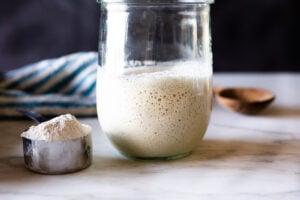
Simple Sourdough Starter
- Prep Time: 30
- Cook Time: 6 days
- Total Time: 144 hours 30 minutes
- Yield: 1 ½ cups
- Category: sourdough, fermented, cultured, bread, baking,
- Method: fermented
- Cuisine: bread
- Diet: Vegan
Description
How to make your own Sourdough Starter (see the step-by-step video in post) using simple ingredients with no special equipment, in 6 days, that can be used in sourdough bread. Sourdough Starter is a wild yeast, made from fermenting flour and water.
Ingredients
- 120 grams whole grain flour (whole wheat flour, rye flour, or freshly milled flour) 1 cup, fluffed, spooned and leveled
- Organic White Bread Flour (5-10 lb bag ) I like Shepherd’s Grain or Bob’s Red Mill.
- 120 grams Water per feeding (1/2 cup water)
Instructions
-
- Day 1: Starting in the morning or at night, using a wide-mouth quart jar or Crock or Glass Measuring Cup mix 1 cup whole grain flour (120 grams) with 1/2 cup (120 grams) filtered water using a fork making sure you’ve incorporated all the dry flour. For your first measuring – it is a good idea to weigh the flour, using a kitchen scale so you get an idea of how thick it should feel. It should be like a thick paste. Thick like peanut butter. If you need to add a little more water to incorporate the flour, that is OK, but be precise with the flour. Place the lid on top (using the Weck jar is really handy here) or a damp towel to keep moisture in, or plastic wrap- and let sit at room temperature (70-80 degrees) on the kitchen counter for 24-48 hours, or until you see some bubbling. If you are not sure how warm it is, use a kitchen thermometer and check it a few hours later. See notes for TEMPERATURE.
- Day 2: After the first 24 hours, you may or may not see a bit of bubbling. I prefer to let this rest until I see a tiny bit of activity (bubbles) and sometimes this takes 36 or up to 48 hours. So start “day 2”, when you see a little bit of bubbing. Discard all but 1/2 cup (136 grams) of the starter. (See notes for discard). Add to the remainder, 1 cup of white bread flour, (120 grams), spooned and leveled, and 1/2 cup filtered water (120 grams), mixing well with a fork. Place the lid on loosely again and allow the mixture to sit at room temperature (70-80F) for another 24 hours.
- Day 3: By the third day, you should definitely see some bubbling- and if not, let it go a bit longer. Depending on how warm your house is and how active your starter, you may need to begin feeding more often, or even move to two feedings a day roughly 12 hours apart, like in the morning and at night. In a nutshell, you want to feed the starter only after it has peaked (metabolized all the flour from the last feeding) and has started sinking down or gets liquidy- this is when it is hungry! This might be 12 hours, it might be 14, it might be 18, or 24, depending on the temp in your house. In very warm climates it may only be 8 hours. It is better to underfeed rather than overfeed here. For each feeding, like before, discard all but 1/2 cup of the STARTER (keeping roughly ½-cup of starter in the jar -4 ounces or 136 grams) Add 1 cup Bread Flour (spooned and leveled) and 1/2 cup water to the 1/2 cup starter and let this rest at room temperature for 12-24 hours or until the starter looks “hungry” again before repeating.
- Day 4: Feed 1-2 times, discarding all but 1/2 cup of starter EACH TIME. Feed 1 cup bread flour, 1/2 cup water. Look for the hunger signs. Hopefully, you’ll begin to see some rising and falling. It’s helpful to put the starter in a clean jar and mark the beginning level (with sharpie, string or rubber band) so you can easily see this. ***If for some reason your starter looks like it is still rising at the time of second feeding (at night) and there is no evidence it has fallen or no slide marks, it is still “eating” so skip this feeding and feed first thing in the morning. AGAIN, Feeding it when it is “not hungry” will basically dilute all the growing yeast and make it lethargic. Better to starve than overfeed.
- Day 5: Feed again, 1-2 times, roughly 12 hours apart, or when hungry, discarding all but a 1/2 cup the starter EACH TIME. 1 cup bread flour, 1/2 cup lukewarm water. The starter should look active, bubbling, rising, sliding down, hopefully, close to doubling in size. (If not, repeat this day until starter doubles in size within 8-12 hours of feeding- and read the troubleshooting section.)
- DAY 6: Give it one last feeding. Discard all but a 1/3 cup. Add 1 cup flour ( 120 grams) and 1/2 cup water, and place it in a clean jar so you can see the action clearly. You can use a sharpie or place a rubber band around the jar to mark the beginning level. The starter should hopefully double in volume within 6 hours of feeding. When it peaks, DO THE FLOAT TEST: To test the starter, place a teaspoon of starter (just from the top, while it is peaking, don’t stir it down) in a glass full of water, it should hopefully float. If it does, you can make sourdough bread. Tonight! Let the starter keep resting at room temperature or a few more hours allowing it to fully metabolize the flour, perhaps sinking a little before making your dough. You want to make dough with slightly hungry starter. Place the remaining starter in the fridge and feed it in a week. You’ll have enough stater to make one more sourdough loaf during the week, and still have enough to feed. If you want to wait to make bread until later in the week place starter in the fridge. Be sure to feed it in 7 days. Read maintenance section.
- At this point, if your starter does not double in size don’t give up! Often it just takes longer, sometimes up to two weeks, especially if it’s cold. Continue feeding one-two times a day (only when hungry) for a few more days, until you see a visible rise and fall. Read the troubleshooting section. If you need to take a break, just put it in the fridge and try it again up to a week later. Don’t toss it- if there are bubbles, it is still alive.
- This batch of starter will make two loaves of bread with enough left over to feed for the following week.
Notes
- TEMPERATURE: The colder your home, the longer it will take for the starter to grow and become active (bubbles). Find a warm spot (70-80 degrees) for the best results. On the stovetop, with the light turned on, or on top of the fridge. Or in the oven with the light on. On top of a heating pad (set to low) with a towel in between). You can still make the starter in a colder home, it will just take longer- even up to 2 weeks.
- FLOUR: Always try to start the batch by using organic, freshly milled whole-grain flour (wheat or rye) because it has more wild yeast in it than All-Purpose or white flour and will get it active and growing sooner. You can, of course, continue to use whole grain, but I’ve had the best luck using organic “bread” flour for days 2 through 6. People have made a sourdough starter with All-Purpose flour- but personally, this has never worked for me– there are fewer nutrients and wild yeasts in the flour and results in a very lethargic starter. If it is your only option, try mixing in 2+ tablespoons of whole-grain (wheat or rye) with the AP flour per feeding. Feel free to use different flours or mix different flours together. It is OK to use all-purpose flour if in a pinch, but using it repeatedly will result in sad starter.
- WATER: I usually use tap water -but sometimes the chlorine in tap water can inhibit the growth of your starter. Lukewarm water helps fermentation to start faster. Sterilized bottled water is often overly sterile, and can also inhibit. Mineral water, like Perrier (carbonated is OK) can sometimes work miracles.
- HYDRATION: Hydration refers to the ratio of water to flour in terms of weight. It is a ratio. The starter is typically at 100% hydration- meaning equal parts flour and water, in terms of weight. So if you use 120 grams of water, use 120 grams of flour. This roughly translates to 1 cup of flour and 1/2 cup water. Feel free to weigh instead of measure if you want to be more precise, or want to familiarize yourself with the consistency you are aiming for. If using whole grain flours (which tend to be “thirstier”) and your starter seems very thick, it is totally OK to add more water to thin it a bit. I intentionally keep the hydration a little lower here (a thicker starter) so you can more clearly see the rise and fall “action” in the jar.
- STORING AND FEEDING: When your starter is kept cold, in the fridge, you don’t need to feed it as often- only once a week. Feel free to feed it “cold”, and put it right back in the fridge if you like. If you keep it out on the counter, you’ll likely need to feed it 1-2 x daily (or just watch and feed only when hungry). Cold slows down the fermentation, heat speeds it up.
- USING: When you need to use your starter for baking bread, feed it 10-12 hours before making bread dough, using it after its peak height. For a more “sour” flavored bread, use the starter straight from the fridge, 3-6 days after feeding. The starter gets more sour tasting the longer it goes without feeding. Feeding the starter the same day as making bread will produce a milder sourdough flavor.
Nutrition
- Serving Size: 1 tablespoon
- Calories: 31
- Sugar: 0 g
- Sodium: 0.2 mg
- Fat: 0.1 g
- Saturated Fat: 0 g
- Trans Fat:
- Carbohydrates: 6.2 g
- Fiber: 0.2 g
- Protein: 1 g
- Cholesterol: 0 mg
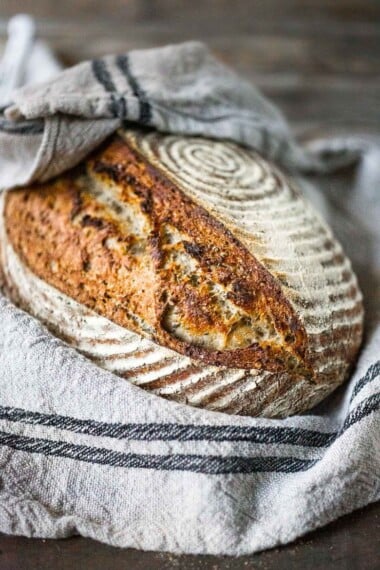

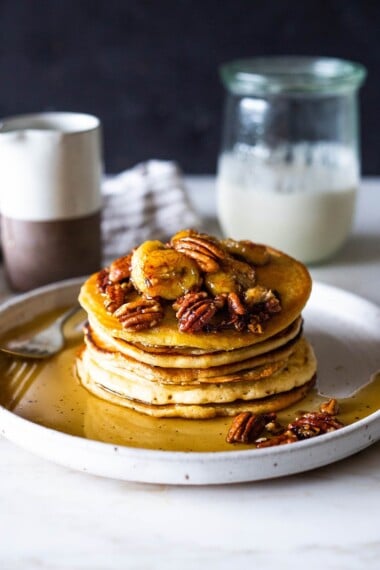
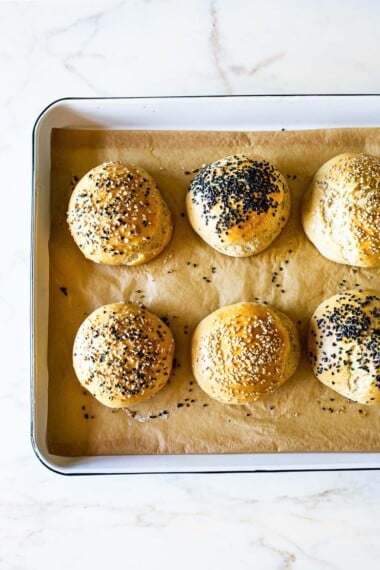







Hi Sylvia! Thanks for the recipe!
I’ve been feeding my starter for over a week, it still doesn’t quite double in size, it becomes more like 1.5 times the size. It does pass the float test though, so I was wondering if I can make bread with it at this point?
Thanks in advance for your response 🙂
I would wait Roman- just keep strengthening it!
Can I use whole wheat flour instead of whole grain?
yes Casey!
Awesome, I’m excited to get started! Thanks!
Hi Sylvia,
I am very excited to inform you that after 3 trials my sourdough mother is strong and healthy. Here on the East Coast in the spring the temperature is quite fluctuant and the mold in our pipes is the black type so it has over time worked out! I have shared my mother as well as made crackers, flat bread and my first loaf of sourdough was loved by all- used the iron dutch oven and all white unbleached bread flour. Our town is out of the organic bread flours, so I adapted and it was delish!
Thank you for your words of wisdom and simple approach.
Gail Robinson, Surf City, NC
Glad this worked for you Gail!
Hello! First time making sourdough and everything was going ok. It was rising, I could tell my starter was hungry by liquid water at the top. Now I’m at a stand still. It won’t rise. Should I attempt to just make some bread?
Hi Garielle- I would try to nurse your starter back to health. Read through the starter post and trouble-shooting section there. If it is not rising in the jar, it will not likely rise the bread. Goal is to have it double in size in 6 hours after feeding.
Ok thanks! Is their such a thing as to much sun? It’s in a full sun room.
Just don’t put it in direct sunlight, and yes ideally you want it be 70-80F.
Hi Sylvia, my starter rises in 5-7 hours but showing no sign for hunger.. I probably over fed it but now it’s been 30 hours and still not hungry..?
So it just stays up high and doesn’t sink down?
So it finally sank a bit.. all this time it’s been sitting on the counter at around 78 degrees.. granted I added home made kefir to it from the beginning as a after the first 24 hour it wouldn’t do much previously.. so over fed it?
But now it’s 10pm and very tired and don’t want to stay awake to babysit.. so feed it in the morning?
yes that is fine!
I fed it this morning and reading all the comments here I expected to be soft but it was tense. I’m not sure what is happening. After the first 24 hours it gets too liquidiy now it’s to dense..
It is supposed to be thick and dense when you first feed it- like a thick paste. As the starter metabolizes (eats) the flour it should get light and bubbly. If it gets liquidy, you’ve left it too long without feeding, but it should be fine, stir it, discard all but 1/2 cup and feed again.
Thank you but the problem is that it’s NOT sinking! It has reached its peak 4 hours ago and no sinking. And it’s just going to get hard/dry but no sinking. What am I supposed to do now? Been messing with it for a week and I have to have this for Cancer diet!
Ok then stir it down, maybe give it a couple of hours at its peak first- then stir it down, discard and then feed. You are keeping it covered? It should not be getting hard and dry with a lid placed on top. Keep me posted. 🙂
Help! I’ve tried this starter 3 times. Each time I start with whole wheat flour and then switch to the Aritisan Bob’s Red Mill white flour and it stops growing. Any ideas what I could be doing wrong?
I would recommend using a couple of tablespoons of whole wheat mixed in with the white. 🙂 And don’t stop, just keep going the 3-5th day can be less active.
Hello,
I am on day 4 of the starter and am having trouble with it rising. On day 1 and 2 it did fantastic, peaked and metabolized however, ever since day 3 it has not risen at all. It is bubbly on top and the texture is runny but there are no signs of rising. Should I continue to feed it once a day even though it is not rising? Should I change flour (using bread flour) or should I start over? Pease advise ☺️
Hi Jennifer- Wait to feed until signs of hunger- always. Yes, try switching up the flour. 🙂
Mine is kind of the same. Day 1 took 2 days, but was fine. Day 2 I fed it, and the next morning I found it had exploded out of the jar. But it was liquidy and bubbly, so i stirred it up and saved a 1/2 c of what was in the jar and fed it again. It is now Day 3. And it is flat. I dont know if it never rose, or if it rose and fell overnight. It has 3 layers…the base, then what I guess is water(?), then a little more of the flour off-white color, just a little bubbly. Is it time to feed it or wait til tomorriw?
If there is liquid ( water) then time to feed. 🙂
Hi, at the start of day two, I added 1/2 cup of water and 1 cup of flour to all of the starter from day one, rather than just saving a 1/2 cup of it. Is there any way I can salvage what I have now to make starter or should I start over? Thanks
You could probably salvage- just wait until you see action before feeding again. Let it get really hungry, it may take longer…
Pizza dough recipe?
Yes, I know, I need to put one out there! So easy and delicious!
I’m going to use this in my pizza recipe. I only have 3 days of stater n will let you know how it works out in 4 more days. Only one problem I make about 20 pizzas a day!
Wow Gene- a lot of pizzas! I use this in my pizza dough as well- makes for a great crust!
I just want to thank you for all of the detailed and inspirational directions, and all of the information you have given for the sourdough bread starter. I know a lot of time and energy went into this, and you did a great job.
I started this in early March and as of today, I have successfully baked two sourdough rounds, one sourdough rye loaf, one chocolate sourdough cake (using discard), and I’ve gifted starter to family. I am so excited to be on my very own sourdough journey.
Awww, thanks Teresa- glad it worked for you!
Sylvia,
I am making your bread recipe tomorrow. My starter stays in the fridge in a jar with a sealed lid. While it is on the counter rising for my dough, do I need to leave the lid cracked open or is it ok to leave sealed?
I would leave it loosely placed on top.
Thank you so much.
I guess I should have asked this too. In the fridge, leave the lid sealed or loosely placed on top?
Loosely placed on top. You want air to be able to escape (from the bubbling) so jar doesn’t explode, but jar covered to keep moisture in. 🙂
Hi, what should I do if I’m on day 4 and my starter is watery and bubbling but not rising?
Just keep going. 🙂
I made this recipe on the first feeding I removed half of the mix fed 1 cup flour 1 cup water Rose to a cup. 2nd day, rose 2 more cups, removed 1/2. 3rd day, fed 1 c. flour, 1/2 c. water, rising out of the quart jar. Why do I feel like this was a waste of time and a lot of money to me.
Yes, I see how it could feel that way, but after you get the starter active and going, the feedings will only be once a week.
Hi! I love this recipe and your sourdough bread one as well! I use that one weekly and have been telling everyone about your recipes and website. So much so, many friends are asking for pieces of my starter for themselves. I cannot find any recommendations on here yet, of what you suggest when giving pieces of the starter away. Any advice?
I would give them 1/2 cup starter with directions on feeding ( or refer to this post) and maybe one cup of flour to get them started? It would be nice gift to give the starter away in a quart jar, so they don’t need to go out and get a jar too!
This is my second attempt, but first with yours. 8 hours ago I fed my starter as Day 2 (48 hours after first mix, as it was still pretty pasty yesterday.) It is about to spill over the top of the jar! It’s bubbly and looks great, but is about to bubble over the top of the jar (it’s about quadroupled since this morning!) Should I discard some and keep letting it peak? It doesn’t look like it is hungry yet. It looks a thousand times better than my first attempt thanks to your recipe!
Thanks Jillian.I would just let it peak before discarding. Use a differnt container if need be for a few days.
I cannot get the videos to play. I did check my cookie settings to allow “feastingatcom.com”. Still didn’t work.
Please help.
Can you try a different browser?
This recipe for sourdough starter works! It’s my first time making it but I followed the directions and within 6 days I had starter bubbling out of the top of my Weck jar. I started with a KA whole wheat white flour because it’s all I could find and then used KA Bread Flour for every other step and it’s worked beautifully. I never got to the feeding it twice a day stage, so I’m not sure what happened there but it’s happy and overflowing the jar and passed the float test. Making my first loaf of bread tonight. I am just unclear now as to what I do after I use some for the bread? Do I feed it again after I take the 1/3 cup out to use or just wait till it’s reg once a week feeding? Thanks so much for a great recipe and video, that was super helpful.
Yay! Glad this worked. You can just put it straight in the fridge.
I’m starting this now! Excited, thanks for posting. Instead of using all bread flour, can I use a mix of the whole grain and white bread flour? Trying to keep it as healthy as possible for now 🙂 thanks!
You can, but for your first loaf I suggest only ½ cup whole grain. So you can get the feel of the dough.
I’ve really enjoyed following your recipe I just had one question. I’ve been feeding it for a week now and after a couple of days it stopped rising but still got watery and was bubbly at the top. I realized I had been doing to math wrong and hadn’t been taking enough of the starter out. Do you think I killed it or do I just need to keep feeding it? Thanks!!
Hi- I would just keep going- it will take a little longer, but if there are bubbles, it is still alive, you just need to strengthen it. 🙂
Hi, sylvia, i live in a warmer country, the temperature here around 26 to 31 C , is it alright to leave it on the counter, or should i i move inside the fridge? it’s my second day making the starter, thank you so much for the recipe by the way!
Is there a cooler part of the kitchen ( lower) that you could place it? The fridge will really slow things down, maybe too much? Or you could refrigerate overnight, maybe for half the time?
Hi! This is my third time trying to make sourdough starter, but the first time with this recipe. Every time my starter becomes a little more “runny” every time. Is it okay? I measure out the flour and water. And about an hour after feeding it, it looks pretty runny. But there are bubbles. Should I add more flour than I have been?
Runny just means it is metabolizing the flour. You might want to try feeding more often. 🙂
Thank you! Should I feed it even though there’s not much growth in size?
Yes, if it shows the signs of hunger- gets runny enough to pour out of jar, or liquid at the top. 🙂
First, thank you so much for the detailed steps and videos. In my 50’s, I decide to start baking. Who knew. Today, I am making my first sourdough bread from your, also detailed, steps. I have one question. I combed the notes and comments first. When feeding weekly from fridge, do I leave it on the counter for any period of time or right back to fridge from feeding?
Hi Gregg! You can do it either way. If you plan to bake within the week, you could leave it out a bit, if waiting a week, just stick it back in. 🙂
Thank you so much for the quick response.
Sylvia – mine is doubling in size (on the day 7 protocol) but it takes about 24 hours to do so. It does float in water. It’s also really cold in TN. What is your suggestion? Should I keep feeding it until it is doubling at 6 hours? Or refrigerate and wait for the temperature in TN to get warmer before using it? Thank you kindly!
You know, you could go either way. Could you put in oven (heat off) with light on and see if that hastens it any? If you do try to make bread, just know it will probably take a lot longer to proof- but still could work?
Thanks for getting back to me so quickly!! I could definitely the oven trick. I’m honestly so stoked I’ve made it this far! I might even feed and wait till next week it’s supposed to warm up quite a bit. Appreciate you so much!!
Thanks and good luck Angeli!
Oven trick worked! 12 hours later it’s doubled, will feed again and see if we can get it down to 6 😉 thanks again Sylvia!
Awesome Angeli!!!
Hey Angeli!
I live in TN as well and have been VERY patient with my stater due to the fluctuation of temps (been going for a couple weeks). Last week it was great in the warmer temps but now I’m on “day 7” and it’s not rising as quickly as it has been before. Have you tried baking bread with yours yet? I’m trying to decide if I should go back to 12 hour 1/2 cup feeds or wait and see if it doubles by tonight.
Hi Kayla!! I have not yet tried to bake with it. Last update it was doubling in size at 12 hours in the oven (with the light on) but then I refrigerated it for a week because I had friends in town. Just fed it again today. I may try to bake with it soon and will let you know!
Kayla!!! I used my sourdough starter to make the no knead sourdough bread (still doubling at 12 hours). I let the dough proof for 21 hours (went to work the next morning and came home). It turned out great!!! Definitely recommend trying it if that feels right to you 🙂
Hi I started well with my starter… I had it rising and falling on day 3 however my aga went off overnight and it got cold and now my starter has stopped doing anything. The aga is back on but it has now been a day and a half without any more movement. I can see it has bubbles in it but it has not gone runny. I am not sure what to do. Do I leave it longer to see what happens or do I feed it again and hope that wakes it up?
Wait to feed until it is runny enough to pour out fo the jar. 🙂
Thanks for getting back to me 😊. Will watch and wait… until it is runny 😊.
Thanks again for the recipe. It worked a treat. Today is my day 6 and it passed the 2 tests, do I feed it straight away again and put it in the fridge, or do I wait another week before I feed it?
You can go ether way. 🙂 Feed it if you don’t plan on using this week.